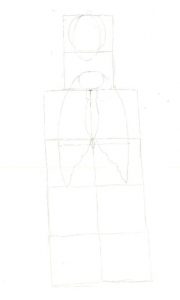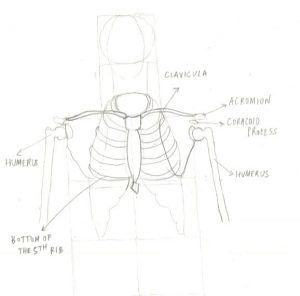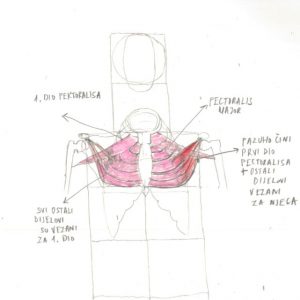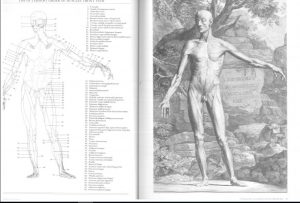Why is the Shoulder Girdle the Mosti Difficult Thinf to Draw on the Human Body (part five)
The last post delt with the dorsal side of the shoulder girdle which is characterised by a very mobile scapula. The pectoral part of the shoulder girdle consists (its bony part) of the “acromion” (a part of the spine of the scapula, remember?) and the “clavicula” touching and forming a part of the shoulder joint. The clavicle is attached to the sternum and it makes for the the single bony attachment connecting the rib cage and the bones of the shoulder girdle. The fact that the shoulder girdle has no other bony connection to the rib cage is the secret of its exceptional mobility.
Let’s dive into the front part of the shoulder girdle. We have mentioned time and again that, in the mind of a trained artist, the front of the body (skeleton) doesn’t differ from the back. Artists have x-ray vision. Let’s draw the front of the rib cage:
As we already mentioned- the clavicle is connected to the stenum in the front and the “scapula” in the point of the shoulder (also called the “acromion”) in the back.The fact that the calvicle is connected to the scapula makes for the clavicle being automatically engaged in the arm movements to the front and to the back. Arm movements to the side of the body involve the clavicle only if the arm is raised above the shoulder level.(you should try it outand see for yourselves) The glenoid cavity ( a hole where the head of the humerus fits in) is positioned underneath the acromion. The shoulder joint is a sensitive one and therefore has a process fixed right above it in order to protect it. Its name is the coracoid process and the name has a very poetic meaning ( derived from greek ) : “the protrusion which looks like a raven’s beak”.
The whole of the frontal bony structure of the shoulder girdle is covered by a large muscle, familiar to all the buff boys at the gym: the pectoralis.However, the boys in the gym are usually unaware that their beloved pectoralis is a muscle group consisting od two muscles: pectoralis minor and pectoralis major ( clearly the large and the small pectoral muscle).
And so pectoralis minor according to manifoldly quoted Richer: ” origin.from the external surface of the 3rd,4th and 5th ribs”, and “insertion.to the coracoid process”. The function of pectoralis minor : “pulls down the point of the shoulder”.
R.B. Hale claims that the artists consider pectoralis minor to be a kind of a shelf upon which the pectoralis major lies. The chest, in well developed men and women, is very flat if we consider the ovoid construction of the rib cage underneath the pectoral group. The true function of the pectoralis minor (apart from the anatomical one by Richer), according to artists,is to support the pectoralis major and give the chest a flat, planelike quality. The anatomical role the pectoralis minor plays is ( as I already stated) is pulling down the point of the shoulder,which is a task already performed by the force of gravity and considering that the job of the pectoralis minor is not of grand importance except that without it the chests of the gym rats wouldn’t be as impresssive…
To further demonstrate our point we shall include the drawing from the beautiful anatomy by Albinus from the year of 1747. All of the drawings were done by the master engraver Jan Wandelaar. The charming backgrounds of the precisely drawn flayed figures were his idea and they were supposed to help the figure look three dimensional. The anatomy book was published by Watson and Guptill in 1988.
The muscles on the flayed figures are displayed in layers. On the print above we can see the pectoralis minor clearly as it represents the deeper layer of the pectoral muscles where the pectoralis major is absent.
Pectoralis major, when present, consists of more pieces which stick together. The first peace starts at the clavicle (just next to the sternum), and ends at the “crista tuberculi majoris humeri” (its name sounds terrible, but it’s only a bump on the top of the forearm). The rest of the pectoralis major pieces ( the number is individual and ranges from 3 to 5) start at the sternum and are linked to each other at the top and in such a way that they form the flap of the armpit.
This is the surface layer of the pectoral group featuring pectoralis major by Albinus:
And thus we come to the end of the frontal part of the shoulder girdle. As a reward for the persistance in mastering such daunting a task, here is a short poem by Ezra Pound. He was trying to embrace his brilliant predecessor Walt Whitman. Whitman annoyed the hell out of Pound, but he accepted his influence in the end as I hope the students will accept the neccessity of deep studies of complicated anatomical matters as the only way to learn to draw properly.
“I make a pact with you, Walt Whitman –
I have detested you long enough.
I come to you as a grown child
Who has had a pig-headed father;
I am old enough now to make friends.
It was you that broke the new wood,
Now is a time for carving.
We have one sap and one root –
Let there be commerce between us. “







Najnoviji komentari